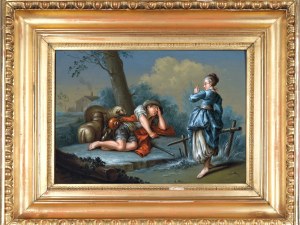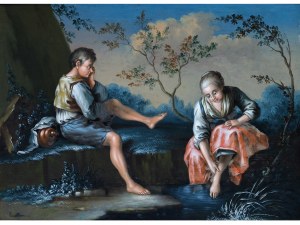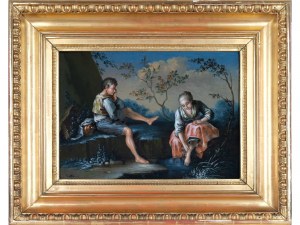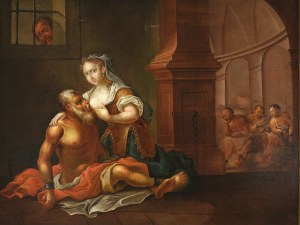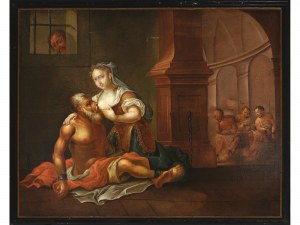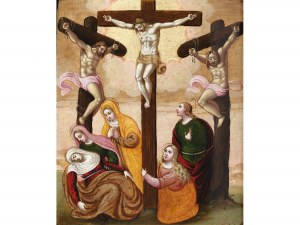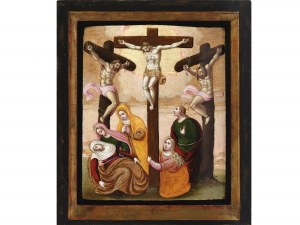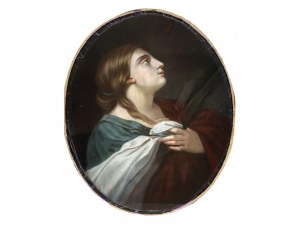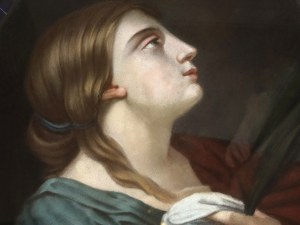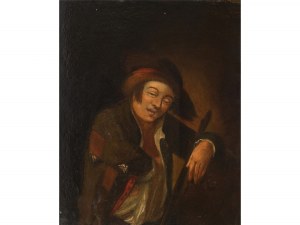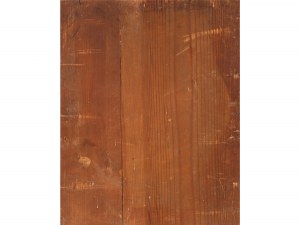German School [19th century].
Servant
technique: oil on sheet metal
dimensions: 31.5x26 cm/42x37 cm
unsigned
Metal as a sub-image played a lesser role than canvas and wood, and was used almost exclusively under the oil technique. Mostly copper, silver, lead sheets were used, less often brass, steel or other metals. The greatest use as a sub-image of sheet metal was in funerary painting, epitaph plaques, also in advertising painting - such as signs, company signs, etc.
Metal substrates were also used in miniature painting and small format paintings, especially in the 17th-18th centuries.
Sheet metal sub-images are characterized by heavy weight, but at small formats they also have advantages - durability of the substrate, lack of possibility of negative influence of external factors from the reverse, and in the case of copper, brass, lead sheets - reaction with oil binder significantly accelerating drying of the painting.
Artists creating in this technique thought that the paint would adhere better to the material, which, unlike wood and canvas, is not subject to changes resulting from dryness or moisture. They also believed that the quality of the bright colors would not change, that they would remain eternal.
Cose piccole - small paintings were gaining popularity. Paintings on copper attracted collectors and founders of art cabinets not only in Rome, but also in other areas of Italy. Avid collectors, for example, were the Tuscan princes Francis I, Ferdinad and Cosimo II de Medici. They were mainly interested in paintings on copper with mythological and allegorical scenes. From Italy, painting on copper soon moved to the Netherlands. Many of the authors there became familiar with painting of this kind during their travels to Italy and used this knowledge upon their return home, such as Jan Brueghel the Elder and Hendrick van Balen. Painters of the younger generation also largely applied these skills. Among their favorite subjects were so-called "poems," i.e. scenes from ancient mythology or ancient history. In the late 17th and early 18th centuries, Dutch painters delivered their works to German princely courts in Düsseldorf, Berlin and Würzburg, where virtuoso paintings on copper were valued extremely highly. Painting on copper sheet coated with silver or even gold foil was a particularly sophisticated method. The delightfully shimmering color effect, noticeable especially on the clear blues, visually extraordinary, introduced these works among the sought-after, precious jewels in the collections of the most discerning collectors. Besides, gold and silver surfaces here were perceived similarly to the gilded or silver-plated backgrounds of medieval paintings. Gold was a symbol of heaven, infinity and eternity, and sunshine. From silver, on the other hand, radiated a cool light formerly compared to moonlight.
Copper as a substrate persisted in European painting throughout the 17th and 18th centuries. It demonstrated the resilience of a durable material and the constancy to protect the beauty and brilliance of colors. Unlike paintings on stone, which became the fond hope of many artists in the 16th century, it met the desire for the work to outlive the master, for the painting to become eternal, which it mostly fulfilled.
In the past, masters painted on copper sheets, which reigned over other metals as a base for painting until the mid-18th century. The first paintings on metal substrates appeared in the 16th century in Italy. The oldest known among them are by the brush of M. Caravaggio.
Copper was produced by hand until the end of the 16th century. Then rolled sheet began to be produced, and in 1869 electrolytic copper was obtained. After cleaning from oxides, smoothed copper is covered with an opaque oil paint mortar. Copper is sensitive to fatty acids, which is why stains show up on the oil painting after some time. It is advisable to use deacidified or low-acid oils and resins for painting. In addition to copper, iron sheet was used most often since the 18th century. The most suitable are fired in charcoal (not coke), as they rust less. Tinned iron sheets, the so-called white, began to be used in painting in the 19th century. After the surface is cleaned of rust and smoothed, the sheet is covered with linseed varnish and fired over a fire. It is then coated with mortar. The surface of the plates should have a fine grein, as then the adhesion of the mortar is greater. Metal plates are cleaned with a mixture of alcohol and slurry chalk with a small addition of ammonia. After this procedure, thinly melting mini paint is introduced on the rinsed and dried plate, followed by lead white giving a suitable background. Do not use poppy oil or other oil white for priming. Tinned or galvanized iron sheets are not suitable for painting. The most suitable metal for a substrate for painting purposes if aluminum. Aluminum is resistant to acids, less resistant to alkalis, and does not affect the drying of oil paints. With the help of anodizing, it is possible to coat aluminum sheet with an oxide coating, which accepts oil paints as well as casein paints. Aluminum is more expandable than iron, so it is not advisable to speed up the drying of mortar and paint by adding siccatives. A slower drying oil should be used.



![GERMAN SCHOOL [19th century], Servant](https://img1.one.bid/img/4375/1113169_1q.jpg?1670181017)
![GERMAN SCHOOL [19th century], Servant](https://img1.one.bid/img/4375/1113169_2w.jpg?1670181017)
![GERMAN SCHOOL [19th century], Servant](https://img1.one.bid/img/4375/1113169_3w.jpg?1670181017)






